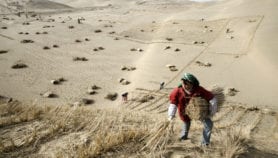03/09/19
CoP14 on desertification tackles ‘land-drought nexus’

By: Ranjit Devraj
Send to a friend
The details you provide on this page will not be used to send unsolicited email, and will not be sold to a 3rd party. See privacy policy.
[NEW DELHI] Weather-related disasters such as droughts, forest fires, flash floods and soil loss form the background for the 14th Conference of the Parties (CoP14) of the UN Convention to Combat Desertification (UNCCD) this month (2–13 September) in the Indian capital of New Delhi.
Ibrahim Thiaw, executive secretary of the Convention, reminded delegates at the opening session on Monday (2 September) that although recent adverse weather events and scientific assessments presented a grim picture, there were opportunities for change and action.
“The agenda shows that governments have come to CoP14 ready to find solutions to many difficult, knotty and emerging policy issues”
Ibrahim Thiaw, UN Convention to Combat Desertification
Among key scientific assessments expected to inform CoP14 is the Special Report on Climate Change and Land released by the UN Intergovernmental Panel on Climate Change in August, which highlighted increasing pressure on land brought on by human action and climate change.
“While the science and events around us must get our full attention, we should never, ever lose sight of the inspiring moments or opportunities opening up or are happening around us that we can build on to break vicious cycles, trends or behaviour,” Thiaw said. “This is what will move us forward.”
Starting Tuesday (3 September), delegates work through 30 decision texts, with the negotiations on dealing with drought and land tenure slated to take priority.
The New Delhi meet includes the 14th session of the UNCCD’s Committee on Science and Technology (CST14). It will consider three major technical reports newly published by the Science-Policy Interface (SPI) with clear objectives.
The first SPI report contains guidelines for the estimation of soil organic carbon in the context of land degradation neutrality planning and monitoring. The report follows on the realisation that there are carbon benefits to the implementation of sustainable land management.
According to Thiaw, the first SPI report aims to create an enabling environment for land degradation neutrality (LDN) and its potential contribution to enhancing the livelihoods and well-being of people and of the environment.
The second SPI report addresses the ‘land-drought nexus’ and is designed to enhance the role of land-based interventions in drought mitigation and risk management. It works to translate current science into policy options relevant to the 197 parties to the Convention.
Prakash Javadekar, India’s minister for environment, forest and climate change, said the SPI reports will ensure a “strong scientific foundation for key policy decisions over the next two weeks”.
Javadekar took over the presidency of the CoP from China’s minister of state for forestry and grassland administration Zhang Jianlong for a two-year term. At a plenary following the inauguration, Javadekar said only “strong human intent and intellect combined with technology” could halt the acceleration of climate change, land degradation and biodiversity loss caused by human action.
Noting that some of the world’s most populous countries, starting with China and India, have presented voluntary LDN targets, Javadekar called for further international commitment to find new ways, including sustainable development methods and technology, to restore degraded land.
Javadekar said 122 countries, including Brazil, China, India, Nigeria, Russia and South Africa “have agreed to make the Sustainable Development Goal of achieving land degradation neutrality national targets”.
On the agenda of CoP14 are the following: land tenure, drought management consumption and production flows influencing agriculture and urbanisation that would consume 80 per cent of the most productive agricultural land in Asia and Africa, ecosystem restoration and nature-based solutions to fight climate change.Javadekar said he would consider it a measure of success for CoP14 if the Conference could arrive at a consensus on its thorniest issues such as dealing with drought and land tenure.
An estimated 7,200 participants including 90 ministers as well as other representatives of governments, non-government and intergovernmental organisations, scientists, women and youth from the 197 parties are expected to be involved in taking the 30 decisions on land-use policies and emerging issues such as forced migration, sand and dust storms and droughts.
“The agenda shows that governments have come to CoP14 ready to find solutions to many difficult, knotty and emerging policy issues,” said Thiaw. “More than 70 countries already have robust national drought plans, compared to just three countries only four years ago.”
This piece was produced by SciDev.Net’s Asia & Pacific desk.
More on Desert science
News
Climate change can dry south Indian river, says new study
[NEW DELHI] Climate change could lead to huge01/03/12
News
Agroforestry can fix Pakistan’s depleting tree cover
[ISLAMABAD] Using a mix of trees and crop species can help rejuvenate Pakistan's deteriorating ...16/12/11
News
Pakistan seeks tech fix for impending water crisis
[KARACHI] Pakistan is seeking technological solutions for an unfolding01/08/11
News
South Asia News in brief: 1–15 March 2008
Below is a round-up of news from or about South Asia for the period 1–15 March.20/03/08
News
Soil degradation issues ‘swept aside’, say experts
Soil scientists have called for more targeted research and strict guidelines to stop what they say is the m ...07/09/07
News
UN: Policymakers must rethink desertification
[BEIJING] A new policy report from the United Nations University (UNU) urges governments to adopt a more co ...28/06/07
News
Islamic fund created to secure food in Niger
A group of Islamic states have approved a five-year US$370 million fund to help combat desertification and ...19/06/07
News
Local people ‘vital to preventing desertification’
Integrating the livelihoods of local people into environmental management can help prevent the desertificat ...14/05/07
News
Forced migration key issue at desert meeting
Desertification could create more than 135 million refugees, as droughts become more frequent and climate c ...15/12/06




